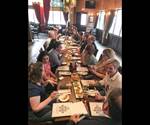Collaborative Workforce Development
MoldMaking Technology editorial advisory board member Kylee Carbone of Westminster Tool shares what she feels is essential to successful workforce development in moldmaking.
Kylee Carbone, EAB member and Westminster Tool’s director of human development and marketing, shares key aspects of building a successful workforce development program. Kylee has been very involved with building the company’s internal skills training program, Westminster Academy.
Based on my experience, I can honestly say that implementing a workforce development program is a large, multi-faceted undertaking. I believe that collaborating with other members of the community provides a multitude of resources that makes tackling such a big project more feasible. The resources that we have gained from collaboration has allowed us to advance Westminster Academy further than we could have done as an individual organization. We have formed relationships with the local school systems, neighboring manufacturers and our local government to create an environment that supports manufacturing workforce development in Eastern Connecticut.
The collaborative efforts of the Eastern Advanced Manufacturing Alliance (EAMA) have provided this phenomenal environment for workforce development. Often, people are intrigued when they learn that EAMA is comprised of over 60 diverse manufacturers. Each of the organizations does something vastly different from what the others do, but how the organizations go about it is not. They all need qualified people who are hard workers and who have a baseline of entry-level, manufacturing-specific skills.
Members of EAMA came together to create the Advanced Manufacturing Certificate Program at Quinebaug Valley Community College (QVCC). The program, which was developed based on our EAMA members’ needs, provides comprehensive training that allows someone without any manufacturing experience to begin a career at a company like Westminster Tool. Westminster Academy is then able to focus its efforts on the more complex skills that would not to be taught on the outside: the processes, methodologies and thought processes that are unique to Westminster Tool.
Perhaps what has been most valuable to me is meeting the people who are having such a positive effect on workforce development. Colleen Lugauskas, principal of Moosup Elementary School, is one of those individuals. Colleen had a dream of establishing a makerspace program at Moosup. Her program will provide a pipeline of students who are passionate about working with their hands into QVCC’s Advanced Manufacturing Certificate program. Progressive thinkers like Colleen are shaping the future of workforce development. Collaboration will not only help to implement, grow or improve workforce development initiatives, it will inevitably provide the opportunity to improve and grow all other areas of a business.
Related Content
-
How to Foster Innovation Through a Culture of Education, Mentoring
Dynamic Tool Corp. shares its strategy for building a team with the right attitude and aptitude to deliver innovation that meets customer expectations.
-
MMT Chats: California Mold Builder Discusses the Difficulties with Silicone Molding and the Power of the Magic 8 Ball
MoldMaking Technology Editorial Director Christina Fuges sits down with M.R. Mold President and Owner, Rick Finnie, to discuss how he began his moldmaking career, M.R. Mold's LSR Education, and the struggles of working with silicone. This episode is brought to you by ISCAR with New Ideas for Machining Intelligently.
-
Eden Tool and Eden Manufacturing: A Story of Resilience, Growth and Innovation
This critical parts manufacturer, founded on solid tooling fundamentals, didn’t get derailed with the unexpected passing of the owner because leadership was already building a solid business, not just a good tool shop. Here’s how they managed change incrementally… and they’re not finished yet.








.jpg;maxWidth=300;quality=90)


